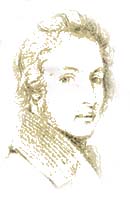

An Appreciation of Thomas Peploe Wood

|
Fine Art student and ex-primary school teacher Patricia Farrow researched the work of Thomas Peploe Wood, visiting churches and local monuments he had sketched and examining his works at the William Salt Library, where many of his sketches are held. Patricia wanted to understand where the artist’s work fitted into the general trend of 19th Century art and summarises her findings here.
An Appreciation of Thomas Peploe Wood by Patricia Farrow
Whatever the income of his father’s two occupations, the Wood family would certainly not have been wealthy. To support himself as an artist, Thomas had to find patrons. One very important patron was William Salt, an active member of the established Church and noted collector of topographical and genealogical books and manuscripts, particularly those relating to Staffordshire. He was also collecting information for a history of Staffordshire and commissioning drawings from local artists. Salt became Thomas Peploe Wood’s patron between 1836 and 1844, the artist making a large number of sketches and drawings of churches, monuments and historic houses during his walking tours of the county.
The artist traversed virtually all of the county on foot. In this he was continuing in the tradition of J. M. W. Turner (1775–1851) and the Derbyshire artist Joseph Wright (1734–97), who towards the end of his life made short tours of the Lake District. Thomas Peploe Wood was born a few years before the opening of the first passenger railway and recorded the countryside just as railways were beginning to impinge on society.
Much of Thomas Peploe Wood’s work was the documentation of churches for his patron William Salt and for the Lichfield Society for the Encouragement of Ecclesiastical Architecture. He also sketched monuments and historic houses for inclusion in the history of Staffordshire that William Salt wished to produce. His work also includes ink, sepia and pencil sketches of street scenes and 16th and 17th Century houses; church ornamentation and sculptural detail; rural life and cottages in disrepair; trees; illustrated poems; farm animals and dogs – and miscellaneous sketches made on visits to Scotland, Dublin and London.
There are also a few known oil paintings of farm scenes and landscapes. Thomas’ eldest brother John was a colourist and taught him to grind and mix colours, a necessary skill for a painter in oils as the collapsible tube was not invented until 1841 and almost certainly would not have been available to Thomas even in his last years.
Thomas’ landscape paintings belong firmly to the Romantic Movement, but without the excesses of the Grand and the Sublime. One aspect of the movement was the portrayal of simple, even primitive, rural life and of drawing directly from nature. Starting as a literary movement, it soon showed its influence on other branches of culture. Landscape painters roughly contemporary with Thomas Peploe Wood who may have been influences are:
David Cox (1783-1859) John Sell Cotman (1782-1842) Thomas Girtin (1775-1802) J. M. W. Turner (1775-1851) Joseph Wright (1734-1797) John Constable (1776-1837) Thomas Gainsborough (1727-1788)
Some of the most appealing of Peploe Wood’s sketches are of animals. The greatest influence on his animal painting would most likely have been George Stubbs (1724-1806), a noted painter of horses, sometimes with their owners or grooms – and the author of ‘The Anatomy of the Horse’ (1766). The horse continued to be a Favourite subject for painters throughout the 19th Century and even into the 20th, for the artists Robert Bevan (1865-1925) and Alfred Munnings (1878-1959). John Frederick Herring (1795-1865), roughly contemporary with Peploe Wood, had great success as a painter of racehorses for the owners of Derby and St. Ledger winners. In a different vein, his ‘Plough Sharers’ gives a rather sentimentalised view of animals and rural life but has much charm. P. R. Farrow
